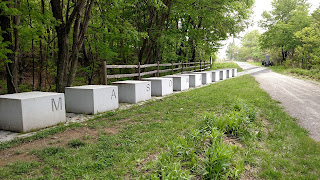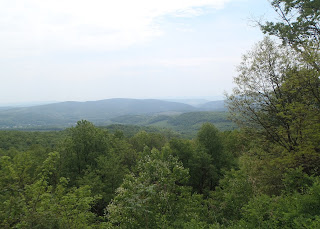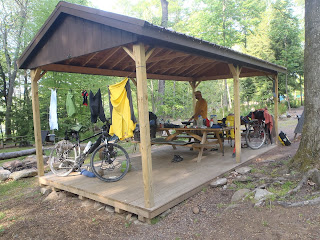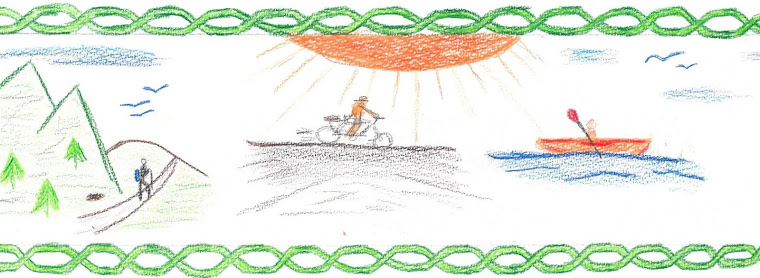 |
| Frostburg's Mountain City Coffeehouse & Creamery |
Vince and I
woke up, showered, dressed, and then climbed up the boardwalk steps from the
Trail Inn to Frostburg’s Main Street for some breakfast. The Mountain City
Coffeehouse & Creamery wasn’t Starbucks but it fit the bill. With a comfortable dining area featuring artwork
by local artists on the wall, the establishment was bright, cheerful, quiet,
and offered a fine selection of breakfast items and coffee’s. I enjoyed a bagel
with cream cheese accompanied by a Vanilla Latte and went back for biscotti
after I finished my bagel. My breakfast was delicious and certainly better than
instant oatmeal.
After
breakfast we returned to the Trail Inn, packed up and clipped panniers on side
racks, strapped tents and pads on the rear racks, and headed back out onto the
trail. This time, however, we were not headed out onto the C and O Canal
towpath but onto the Great Allegheny Passage. Pittsburg was 135 miles to the
west.
 |
Artwork on the GAP access trail. The
Frostburg trailhead in in the background. |
We coasted
down the serpentine path that through several switchbacks descended from the
Trail Inn down to the GAP. I think I used my brakes more than I had the entire trip
as we made our way down to the trail. Along the way we passed some very
interesting installation art as well as banners celebrating Frostburg, biking,
and the GAP. I was impressed with what Frostburg had done with its trail access
area.
Once we
finished our descent to the trail we started climbing up the seven and a half
miles to the Continental Divide.
Frostburg is located at 1,832 feet above sea level. The Continental Divide
is at 2390 feet. According to my calculations that means we would be cycling up
a 1.5% grade for seven and a half miles. Before we reached the divide, however,
we would first pass through Borden Tunnel, across the Mason Dixon Line, and
through Mt. Savage Tunnel.
I found the
climb a grueling, perhaps because we hit it the first thing in the morning and
had not had the opportunity to warm up with a few flat miles beforehand. For
the first time since we left DC Vince was pulling ahead of me as I huffed and
puffed up the grade. Not to be deterred, I maintained slow, even cadence, and
for the record, I was not using my granny gear! I was still on the middle ring
of my front crankset with some reserve in case I needed to slow down even more.
After just
two and a half miles we reached our first tunnel of the trip, the Borden
Tunnel. Even though the TrailBook
recommends walking bikes through the 957 foot long shaft because it is not
illuminated, Vince I simply turned on our bike’s headlights and cycled through.
Just remember to also take off your sunglasses before you do so. The cooler air
in the tunnel was a welcomed relief even though the day had not warmed up that
much
 |
| Crossing the Mason-Dixon Line south to north |
Three miles
past the Borden Tunnel we finally reached the Mason-Dixon Line, a sight I had
really been looking forward to. I had seen several photos of the area that had
been posted on Facebook and on several blogs but wanted to see it for myself.
This artificial boundary that has so defined regional politics since before the
Civil War has become part of my psyche, in part because I have crossed it so
many times, including on my way from West Virginia’s “Northern” Panhandle to
its Eastern Panhandle as I was headed to DC for this trip.
There are
fifty-five counties in West Virginia. All but four of them lie south of the
Mason-Dixon Line. The four West Virginia Counties that make up the Mountain
State’s Northern Panhandle, in which I grew up and recently returned to live,
are not only the four northern most counties of the state but the only four
north of the Mason Dixon Line. That means that I am a true “northerner” and was
now cycling back in my native north.
Vince and I
stopped our bikes at the line, climbed off, and started reading the
interpretative signs and taking a lot of photos. I was fairly impressed with
the way the actual line had recently been marked. Large cut stones sat on the
line just off to the side of the trail, each engraved with a letter to spell
out Mason Dixon. A large stone monument stood on the line on the other side of
the trail, distinguishing between Pennsylvania and Maryland, as the Mason Dixon
Line serves as the dividing line between the two states. Between the cut stones
and the monument a concrete marker in the ground contains the likeness of a
surveyor’s chain that marks that part of the line that the GAP crosses. I
thought it was all very artistic and not at all schmaltzy.
 |
| View looking north from near Big Savage Tunnel |
After playing
tourist around the Mason Dixon Line we climbing back onto our bikes and headed
toward the Big Savage Tunnel. The higher we rode the more the view shed opened
up. After a few miles we stopped at a small trail shelter near a memorial to
Fred R. Schaffer and just before the Big Savage Tunnel to rest, snack, and take
photos of the panoramic view before us, in my opinion better than any views we
had seen on the C and O.
The Big
Savage Tunnel, at 3,300 feet, was the longest tunnel we would ride through
between DC and Pittsburgh. This tunnel,
closed in winter, had lights mounted on the ceiling but we still turned on our bikes
headlights as we rode through as a couple of the lights were out. I marveled at
the engineering as I cycled through the tube and recalled the numerous times I
had driven along Interstate 68 and seen a sign identifying Big Savage Mountain.
I latter checked and learned that where Interstate 68 crosses Big Savage
Mountain the elevation is 2,800 feet above sea level. The tunnel, of course, is
at a much lower elevation.
 |
| Vince and I at the ECD |
A mile and
a half after passing through Big Savage Tunnel, and little past noon, we
finally reached the highest point of our trip, the Eastern Continental Divide,
at 2,392 feet! It was, relatively speaking, all downhill from here but Pittsburgh
was still 126.5 miles to the west. Vince and stopped to take more photos, enjoy
some snacks, and to wait for his aunt and uncle who were to meet us at the
divide. As other riders passed by they too stopped to take commemorative photos
and we all engaged in conversation, talking about our rides and favorite
trails.
While our
climb from Frostburg to the Continental Divide was steeper than anything we had
encountered in the previous four days, gone were the mud puddles, tree roots,
and ruts we encountered while cycling the Towpath. The finely crushed limestone
on top of railroad ballast, typical of much of the GAP, was a welcomed alternative,
even if the climb up to the divide was steep.
Vince’s
Uncle Dave and Aunt Val eventually arrived from west but wanted to ride on to
the Big Savage Tunnel before heading back to Meyersdale, so we waited a the
divide a bit longer. I climbed the embankment from one side of the divide to
the road running across the overpass we were under to take some above the GAP
photos. I later checked and learned that where Interstate 68 crosses the divide
that the elevation is 2,610 feet above sea level, 218 feet higher than where we
were now cycling across it.
 |
| Dave, Val and Vince riding the GAP toward Meyersdale |
Val and
Dave took a little break after returning from the tunnel. Then the four of us
headed downhill toward Meyersdale. Before reaching Meyersdale, however, we
crossed over the 910 foot long Keystone Viaduct. This impressive structure is
perhaps the longest and highest viaduct I have ever cycled across. Anyone with
a fear of heights might have a problem crossing it unless they don’t look down.
A couple
miles after riding across the viaduct we arrived at the Meyersdale’s Western
Maryland Station, now serving as a Visitor’s Center and Museum. I was impressed.
It was the nicest visitor’s center I was in along the entire GAP. Not only did it offer clean, inside restrooms
but also cold water at the fountain, a repair station, picnic tables, benches,
and bike racks. The museum interprets local history, including the railroad,
and several model train layouts take up about half the building. A small
souvenir shop stocks not only trail and railroad related commemorative items
but also snacks and a few essential cycling items like patch kits.
Vince and I
eventually decided that it was well past lunch time so we broke out his
tortilla shells, my parmesan cheese, and each of our packages of tuna and
enjoyed tuna wraps while sitting outside under the sun at one of the picnic
tables. Val and Dave continued to enjoy the museum while Vince and I ate. Even
compared to the excellent fish and chips at Weaver’s and the “Broaster Chicken”
at the Trail Inn the day before, the tuna wraps tasted pretty good, especially
after riding seventeen miles.
 |
| Meyersdale’s Western Maryland Station |
After we
finished eating, Vince and I said goodbye to Dave and Val and left Meyersdale
and headed toward Rockwood, our day’s final destination. I enjoyed meeting
Vince’s family, who offered us any assistance if we needed it, telling us to
just call them if need be. Fortunately, we never needed to.
Our
destination in Rockwood was the Huskie Haven campground, around milepost 43, where
we had reservations for the night. Vince had camped there at least once before
on a previous trip and spoke highly about it. We rolled into what looked like a deserted
campground around 3:30 PM. The only person we encountered was the owner, whom
we paid for the night’s stay. He pointed to our reserved campsite but said that
since we were the only people with reservations for the night that we could
have a covered picnic shelter instead at no extra cost. We took him up on his
offer.
We had
cycled only 28 miles this day, one of our shortest days of the trip, and were
able to rendezvous with Vince’s aunt and uncle and enjoy riding a few miles
with them. Still, I could not help but think that if we had been able to
reschedule Vince’s family reunion and our reservations at the Trail Inn and
Husky Haven Campground that we could have avoided the shuttle from Hancock to
Frostburg by covering more miles per day on the Great Allegheny Passage, which
was an easier, dryer, and faster ride than the C and O Canal Towpath.
 |
| Our pavilion at Husky Haven Campground |
After unloading
the gear from our bikes onto the picnic tables in the pavilion, we rode farther
down the trail, crossed the bridge over Casselman River to Rockwood, and back
up through this small trail town to Husky Haven’s lounge and shower house.
Considering the price, I didn’t mind the commute. We both showered, made use of
the computer in the lounge to check email and facebook, charged our phones,
played a game of ping pong (I won!), and topped off all our water bottles for
the night and next morning. I also washed out my day’s riding kit in the sink
in the shower house and allowed it to dry outside on a line while I showered.
Back at the
covered pavilion, with a roof over our heads, we spread our sleeping pads and
sleeping bags out on the concrete floor of the shelter after dinner rather than
pitching our tents. I ran a clothesline from one shelter support to another to
dry the riding kit that I had rinsed out in the shower house. Then Vince started cooking dinner.
 |
| Vince preparing dinner |
Vince had
enough provisions to make two calzones, so he offered me one and I accepted. As
he followed a recipe from Tara Alan’s Bike
Camp Book, I watched my cycling partner turned trail chef demonstrate his
culinary skills. This was certainly a step above the mountain house meals I had
been preparing each night in camp. The only drawback was that cooking calzones
takes a lot more time and uses a lot more fuel than boiling water to rehydrate
a freeze-dried meal. The calzones were a delicious feast but I could not have
imagined cooking them under a tarp in the rain our first couple of days.
Cooking them in dry conditions while under a pavilion with several tables on a
concrete slab was a different matter.
Other
cyclists, some of which we recognized from having passed them on the trail,
started rolling in and we were no longer alone in the campground. We were
alone, however, in enjoying a roofed shelter and all the other cyclists opted
to put up their tents as they were camped under the stars rather than a roof.
Before
turning in for the night I read in the TrailBook
about our next day’s ride. We were currently camped along the banks of the
Casselman River, which flows into the Youghiogheny at Confluence, one of the
towns we would be passing through the next day. We would also pass through
Ohiopyle and spend the night at Connellsville. The Youghiogheny passes through
both Ohiopyle and Connellsville.
Husky Haven
was just about everything Vince said it was. Sitting on a narrow stretch land nestled between the GAP
and Casselman River, It lacked the primitive qualities of Hiker Biker Campsites
along the C and O but offered showers (and for us a roof) as well as a chance
to check email and charge our cell
phones. The only drawback was that like almost all the other camping options
along the C and O and GAP, train tracks were still active across the river and
I was once again glad I had earplugs.
As I
drifted off to sleep I found myself thinking that this was not the first night
I had slept in Rockwood. Forty-two years earlier I and another friend spent the
weekend with a mutual friend at her family’s country nearby, but that is
another story for another day. Back then I could not have imagined that over
four decades later I would be back in Rockwood, sleeping on the concrete floor
of a pavilion in a campground next to the Great Allegheny Passage, a little
more than half way through a cycling trip from DC to Pittsburgh.
Thanks to
our shuttle from Hancock to Frostburg, we kept both of our night reservations and
met up with Vince’s aunt and Uncle. We were also back on schedule with our
original itinerary.
Here are links to previous installments in the "Spinning Wheels" series:




